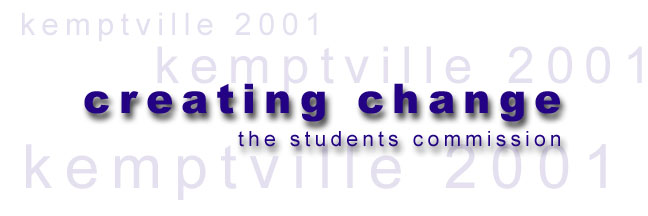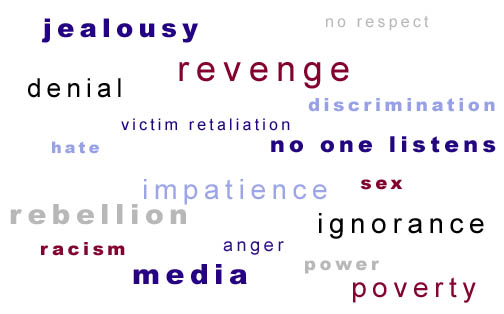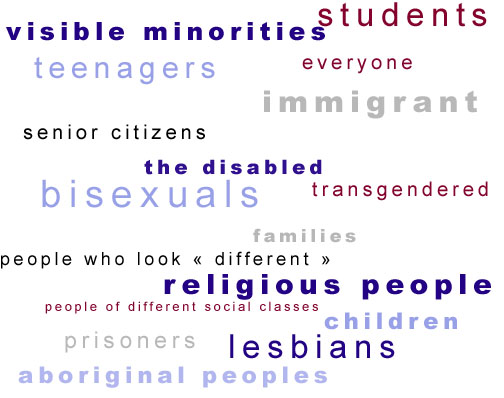
[ back ] [ contents ] [ next ]
![]()

There is violence everywhere. We see it especially in the media - television, radio, newspaper, advertisements, entertainment - but we also see it in our communities. Constant exposure to violence leaves an image, an imprint in the mind of those who see it. Violence has become a source of entertainment. It is also a way of life for many. Some people don't understand those who are different than they are, be it a difference in race, religion, gender, age, or sexual orientation, and often they don't take the time to try. This is where violence begins. Instead they use violence when they are unable to deal with their problems. Although in Canada war is not an immediate danger for youth, there are gangs and bullies that try to empower themselves by picking on people. There are also other instances where violence is present, such as when there is abuse in the home (including, alcohol, substance, sexual, physical, emotional, etc.), or when there is a lack of resources (food, shelter, money), and when people are generally apathetic. We also believe that misuse of power quickly leads to violent behaviour.
Be aware. Talk to your friends about violence because it is out there and it is very real.


Everyone is hurt by
violence. No one is immune: many people are in denial. Violence
exists in nearly every aspect of our lives, in our homes, our
schools, and in our communities. We all suffer because of it. We see
it on television, we hear it in the music we listen to, it is
something none of us can escape. These are some of the victims:
children, youth, the underprivileged, the aged, the innocent,
families, homosexuals, racial, ethnic and religious minorities,
women, men.
"Violence is part of our lives and it seems normal" Donia


I see violent images on television, in video games and on the Internet. I also see them in movies and the news. The media glorifies these images and they seem less real to me. When I see a police officer beating a protestor or being beaten by a protestor, I sometimes forget it's ‘news'. It seems more like a movie.
I hear violence in the music I listen to. Words wanting to beat, wanting to kill, wanting to hurt.
I see violence in my peers at school, in cliques, through gossip, ostracism, name calling; I see fist fighting. In school and out I see violence in sports, fans cheer as hockey players drop their gloves, football players hit harder, and race cars crash. Violence pours out onto the street. Walking alone at night is no longer safe. Fights break out in bars and clubs, but instead of breaking it up, people only applaud them. I do not feel safe on public transportation.
There is violence at work; There is violence at home, violence in me.
"Maybe you don't see violence, but it still exists"

1. walk away
2. talk about it, share personal stories and experiences
3. create awareness about cultures, religions, etc, which would
encourage openness
4. more anger management and conflict resolution programs - more
opportunities to engage in peaceful, non-violent resolution, youth
peer counseling
 5.
education on the causes of violence: e.g. Gang violence workshops for
parents and teens
5.
education on the causes of violence: e.g. Gang violence workshops for
parents and teens
6. alternate programs - using art as a means of expressing violent
feelings,
7. create videos, brochures, posters, website, commercials,
multimedia presentations
8. More recreation and sports centers
9. End The Silence: make as much noise as you can for one minute use
your voice to stop the violence, raise awareness
10. Youth initiated youth oriented anti-bullying, anti-violence
program
11. introspection, self care - keeping a journal
12. access to free programs
![]()

Discrimination is judging without understanding. Discrimination is learned. We are not born with prejudice, we are taught it. We must unlearn it.
The media discriminates. It teaches us to discriminate. Many aspects of society promote closemindedness and from that, discrimination is learned. We can learn to discriminate from our parents, past experiences, peers, through our religions and in our schools.
People discriminate against others because they are different. Many people have trouble understanding people that are different from themselves. Some people prefer to stay within their own traditions and cultures. Fear of the unknown, or just plain ignorance is often the root cause of discrimination. People feel insecure and scared of those things and people they don't understand. People need to get to know you for who you are, not for what you are.
Your appearance is one way that you express yourself and everybody has a certain way they want to look, and a certain thing that they want to say. We must learn to look beyond stereotypes.
It is easier to pick on people who are weak; those who are in the minority. Some people feel better about themselves by putting others down. Also, people envy others for their power, so they try to knock them down and to take it. This competition can exist between race, religions, genders...
If you have a bad experience with a certain group, then it is easy to think badly of the whole group. For example, if a black person has a bad experience with a white person, then they may form bad opinions of all white people.



We see discrimination in different ways. We see it everywhere :
-- I walk into
convenience stores, past signs that read "2 youth at a time." Store
owners and security guards look at me as if I'm a criminal. All bags
must be left at the counter..
-- Whenever I see aborignial people on TV they're either drinking or
sniffing. This is not the way it is
-- A bus driver tells my "goth" friend "You have to wait for the next
bus, this one is full", even though there was still room.
-- The school system is homophobic. No one wants to talk about being
gay, not the teachers, not the principal, not my friends. I tried to
start a gay-straight alliance at my school but there was no support.

Discrimination occurs all around us. Not only does it occur in malls, in the media, on public transportation, and in our schools, but we also see discrimination in our churches, on the Internet, and in our neighborhoods.

Programs and Projects
Addressing Discrimination
1. Education
a. destroy the stereotypes by showing the facts; public speaking,
poster and brochure campaigns.
b. Challenging existing media and their representation of various
communities.
c. Creating our own media (websites, 'zines, tv/radio spots,
newsletters etc)
d. Teach others about other cultures and communities.
2. Awareness, Mediation and Communication Between Communities
a. Self Esteem and Self
Image Awareness
i. be proud of what you are.
ii. believe in your opinion and keep and open mind
b. Peer Mediation Programs.
c. Recreation activities for young people to connect.
d. Exchange Clothes Day, everyone wears a different kind of
clothes.
e. Youth Discussion Groups.
f. Multicultural Day.
3. Key Themes to Success
a. Youth Participation
in all activities.
b. People should be given the right to an unbiased environment.
c. people need to have the tools to speak openly as political
correctness inhibits people's ability to learn about other
cultures,
d. programs must be both national and local.
![]()

There are many problems
with our current education systems. The problems are all very
different, yet all add up to one thing. The system needs help. Be it
a teacher not caring about their students, or the material coming out
of a text book without much relevance to real life, one thing is
clear, the system needs to focus on the needs of the students. In
some cases, the teachers are unavailable to help their students.

Teachers sometimes discriminate against their students due to their appearance. The students have little or no say in what they are taught, and students cannot survive with the extremely limited information they are given in school. The information they are given comes from books, and not from real life experiences. Due to a lack of funding, there is a definite lack of field trips, extra-curricular activities, and resources for the students. As well, there is often too much pressure put on students to do well, and the students are taught to think that if they don't do well, they are failures. Students are often treated not as individuals, but as numbers. Students get bored, because they are sick and tired of learning information which is of no relevance to them, or their lives. The students often feel as though there is no point in continuing their education, and that they have no future. They are often not encouraged to express themselves, but to be just another sprocket in the great business machine.
![]()
The problems don't always lie with the teachers, students, or authority figures. The problems also have plenty to do with the government and their unwillingness to provide sufficient funding to the system. Because of cutbacks and lack of proper staff, teachers are often forced to teach subjects that aren't in their field. Schools are shut down, causing other schools to become overpopulated. The system is a mess, and we need change now.
We feel that students aren't encouraged to participate in the decision-making process at their schools. Either their teachers censor them, or restrict them. Teachers are often dictatorial towards their students, crushing their school spirit. While it may be easy to put all of the blame on their shoulders, we must also take into account that the teachers are quite often overworked, underpaid and stressed out. Also, teachers quite often don't know other styles of teaching, or aren't trained well.
Students should be included in the decision-making process. At the same time, students should want to make change, and not just accept what's handed to them. Too many students are apathetic about their educational experience. If they felt the desire to get involved in the decision-making process, they would not feel as hopeless, because they would know that they are making an effort to make change. The students should also show support to their peers. If you just sit there and accept whats handed to you, there is no opportunity for change.

How to make the system better :
1. Improvements to the
curriculum
i. more inclusive of other cultures; there should be mandatory
multicultural education and awareness (i.e. anti-racism workshops;
create links with street youth, immigrants/refugees, etc.)
ii. There should be more focus on aboriginal culture; more aboriginal
teachers in aboriginal schools.
iii. More specialized courses; offer options for students in the
trades, as well as academics.
iv. "Having a goal for when schooling is finished is a good
motivating factor and gives a feeling of accomplishment" - group
3.
v. students included in design of curriculum

2. Improvements to the
faculty;
i. Staff should be as diverse as the student body
ii. Teacher testing should be implemented all across Canada.
iii. "Mandatory testing of teachers would ensure that students have
the opportunity to achieve greatness in education!" - group 7.
iv. teachers who are paid well and who are more appreciated will be
better at their job.
v. students should be aware of the stress on teachers.
3. Finances:
i. the government needs to stop cut backs and put money in
education.
ii. students should try and raise funds for their schools (car
washes, raffles, bottle drives, etc.)
4. Youth/student
initiatives:
i. start your own project at school (i.e. peer mentor groups,
activist groups, multicultural groups, etc)
ii. advocacy and awareness- do presentations, create and distribute
literature, work together to create change.
iii. communicate with teachers; let them know what you need/want, ask
for help, show them what you can do.
iv. go to the school board, write letters, e-mail, and lobby for
change.
v. become active within your school, for a positive atmosphere, and
to increase school spirit.
5. These steps should begin early in elementary school, and continue until the end of high school.